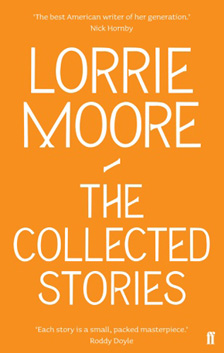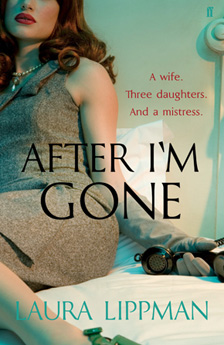Lorrie Moore: ‘How to Be an Other Woman’
by Laura LippmanIt is risky to return to anything that one loved thirty years ago – a boyfriend, a city, an outfit. But I had a hunch that Lorrie Moore’s ‘How to Be an Other Woman’ would hold up pretty well, although it now feels distinctly historical with its references to office work in which the clerical employees use typewriters. And, yet, at the same time, it seems completely contemporary: Charlene, wasting her potential as a secretary at Karma-Kola – oh, lord, I completely missed the obvious joke of that name for all these years – could be the fifth girl in HBO’s Girls.
Charlene meets her boyfriend-to-be on a bus. (Query: What do we call the man in such relationships? She is the ‘other woman’ or mistress, but what is he? The adulterer, I guess, and yet that label is seldom used.) She is reading Madame Bovary, but the book is cloaked in a “Doris Day biography cover”. Charlene’s own cover is just as arch and paper-thin. She uses clever words to pretend that she doesn’t really care about this dead-end relationship. She is given to bad puns, although they are bad puns made with an aching post-modern awareness of how bad they are. (Wordplay is her foreplay. When her lover-to-be makes a comment about the weather, she replies: “It is fit for neither beast nor vegetable.”)
“It is dumb. But it is how you meet.”
Yes, “you”. Moore’s story is written in the second-person. When I teach writing and review the various points-of-view available, second-person is almost a footnote, a topic to be hurried past as it is done so seldom. (I plugged “novels written in second person” into a Google search engine and found a Goodreads.com list that includes Self-Help, the Moore collection in which this short story appears. The list of 20 books included Jay McInerney’s Bright Lights, Big City, perhaps one of the best-known works in this POV, but also novels by Paul Auster, Italo Calvino, Stewart O’Nan, Tom Robbins and The Monster at the End of the Street, a 1971 Little Golden Book about a Sesame Street character.) The danger in second-person is that it can feel like a bit of a stunt, but it makes sense for Charlene, who cannot quite own her own behaviour. She stands outside herself, pretending to be cool and cynical.
 When told that her lover’s wife excels at making lists, she makes her own. Former lovers, four in all. “Clients to see”, which are really lists of the most mundane tasks imaginable, then segue to pro/con evaluations of her situation. She is in love, but she knows it’s probably not going to end well. She obsesses over his wife, Patricia, staring into the wife’s closet on a rare overnight visit to her lover’s apartment, noting the sensible ‘married’ shoes lined up in a row, the toiletries taken from hotels.
When told that her lover’s wife excels at making lists, she makes her own. Former lovers, four in all. “Clients to see”, which are really lists of the most mundane tasks imaginable, then segue to pro/con evaluations of her situation. She is in love, but she knows it’s probably not going to end well. She obsesses over his wife, Patricia, staring into the wife’s closet on a rare overnight visit to her lover’s apartment, noting the sensible ‘married’ shoes lined up in a row, the toiletries taken from hotels.
What do we know about Charlene? She attended college, which earns her the scorn of her work colleagues, as they are in secretarial jobs to pay for their daughters’ education, hoping they will never be caught in such dead-end jobs. She graduated with honours and wears the proof of this, her Phi Beta Kappa key, on a chain, hoping it will attract attention. Her mother is her biggest fan. She grew up in New Jersey.
To be fair, Charlene doesn’t know very much about herself. She literally clings to that Phi Beta Kappa key, playing with it, swinging it around her neck on a cheap gold chain. She doesn’t want to be the wife, a lawyer who specialises in intellectual property law and takes home hotel soaps, but she doesn’t have any idea who she wants to be. When the reader meets her, she has literally pressed her face against a glass, a shoe store near her bus stop. Later in the story, she catches her reflection in windows, but no longer recognises herself. ‘Mistress’ is Charlene’s most vivid incarnation, redolent of romantic old movies.
And then she finds out that Patricia is not her lover’s wife, but the woman with whom he lives since separating from his wife. Which makes Charlene – what? The other other woman? Patricia holds the status that was so important to her. “You mean I’m just another of the fucking gang?” She orders him out of her apartment. “Slam the door like Bette Davis.”
He still calls her from time to time. She fiddles with her Phi Beta Kappa key, doodles. When he asks how she is, she steels herself: “You always, always, say ‘Fine.’”
Is she? I haven’t a clue. Will she be? I hope so, but perhaps that’s my innate optimism. Lorrie Moore, now 57, was not much older than Charlene when she wrote this story and I think her youth is an advantage. ‘How to Be an Other Woman’ is better for its lack of distance and hindsight. The pain is small, but more powerful and credible. And if I find myself thinking today, “Oh, you’ll get over it,” that says more about what’s happened to me since 1985.
 Laura Lippman has been awarded every major prize in crime fiction. She is the author of the Tess Monaghan series and eight other novels. Since the publication of What the Dead Know in 2007, each of her hardbacks has hit the New York Times bestseller list. She lives in Baltimore, Maryland, and New Orleans. Her latest novel After I’m Gone is published by Faber & Faber. Read more.
Laura Lippman has been awarded every major prize in crime fiction. She is the author of the Tess Monaghan series and eight other novels. Since the publication of What the Dead Know in 2007, each of her hardbacks has hit the New York Times bestseller list. She lives in Baltimore, Maryland, and New Orleans. Her latest novel After I’m Gone is published by Faber & Faber. Read more.
lauralippman.net
Lorrie Moore’s ‘How to Be an Other Woman’ is published in Self-Help (Knopf/Faber & Faber, 1985) and The Collected Stories (Faber & Faber, 2008).


